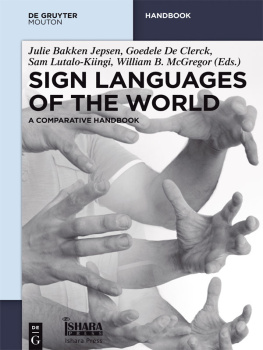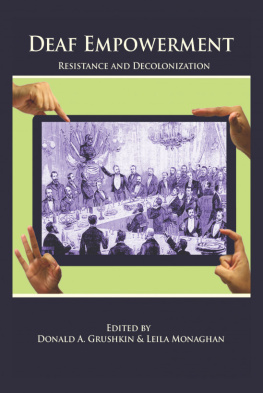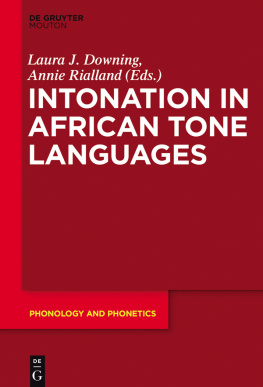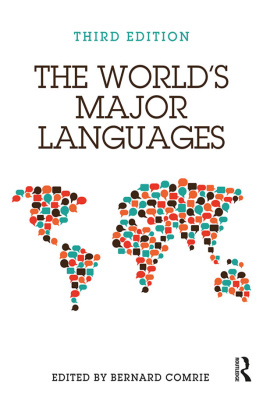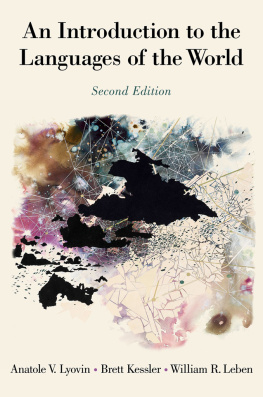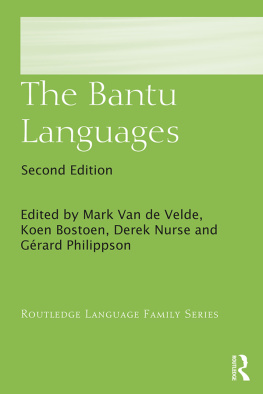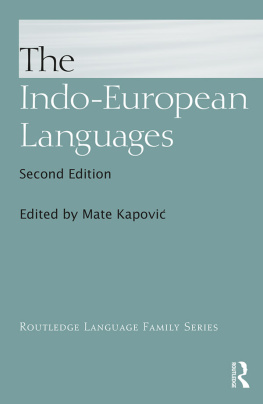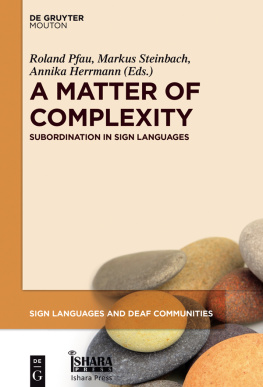
Julie Bakken Jepsen, Goedele De Clerck, Sam Lutalo-Kiingi,
William B. McGregor (Eds.)
Sign Languages of the World

ISBN 978-1-61451-796-2
e-ISBN (PDF) 978-1-61451-817-4
e-ISBN (EPUB) 978-1-5015-0102-9
Library of Congress Cataloging-in-Publication Data
A CIP catalog record for this book has been applied for at the Library of Congress.
Bibliographic information published by the Deutsche Nationalbibliothek
The Deutsche Nationalbibliothek lists this publication in the Deutsche Nationalbibliografie; detailed bibliographic data are available on the Internet at http://dnb.dnb.de .
2015 Walter de Gruyter, Inc., Berlin/Boston and Ishara Press, Preston, UK
www.degruyter.com
Preface
Compiling the thirty-eight papers on sign languages of the world for this handbook has been a mammoth undertaking. Its conception can be traced back to the autumn semester of 2007, with a course Languages of the World in the Department of Linguistics at Aarhus University. One of the references used in the course was Jane Garry and Carl Rubinos Facts about the Worlds Languages (2001). We found this work impressive for the succinct information it provides on a number of spoken languages; at the same time we found it disappointing and problematic that not a single sign language was included. Thus the idea of the present volume emerged, a work that would fulfil the need for readily accessible and comparable information on sign languages that was not just targeted to audiences of sign language specialists and linguists.
Initial invitations to contribute went out in mid-2008. In the intervening years both the number of contributions and the number of sign languages represented have grown, offsetting some originally promised pieces that failed to materialize, or which were published elsewhere. We view this book as an initial step towards meeting the challenge of a comprehensive overview of sign languages of the world. Given the relatively recent documentation of sign languages, especially in some parts of the world (see also the Introduction ), we believe it important to include information about sign languages which have only just begun to be studied. Thus the goal of providing completely comparable information on all of the sign languages treated has been weakened somewhat, and some poorer studied languages have been included. Our hope is that future research will provide the missing information on these languages and, of course, sign languages that have not yet begun to be investigated.
Since the first systematic sign language research of the 1950s, a fascinating new world has opened up. Sign languages and deaf communities have begun to be studied throughout the globe. Sign language users and deaf communities have passed their languages and cultural practices from generation to generation, and their cooperation is crucial to the exploration of their languages. In linguistic and social science research, deaf citizens have found a significant resource supporting their advocacy of linguistic and human rights and equal opportunities in society. Sign language transmission is increasingly challenged in some sociopolitical contexts, and the status and use of sign language in education and other areas have continued to be points of contention, and, consequently, continue to require advocacy. The documentation of sign languages and deaf communities is thus of great importance.
We have been inspired by a desire to stimulate further research and to foster awareness of diverse sign languages and deaf communities around the world. Our intention is to provide deaf communities, scholars, students, advocates, professionals working with deaf people, and general audiences with a resource that presents basic facts and structural aspects of sign languages, and the social, cultural, political, and historical contexts in which they are used.
The papers in the present volume are all original, and each has been specifically written for the volume by an expert or team of experts in the particular sign language, at the invitation of the editors. Thirty-eight different deaf sign languages and alternate sign languages from every continent are represented, and over seventy international deaf and hearing scholars have contributed to the volume. The presentation of alternate sign languages makes it possible to compare and contrast deaf sign languages and alternate sign languages in terms of structural characteristics and socio-political considerations. This, in turn, provides readers with a taste of the linguistic and cultural capital of deaf sign language communities and alternate sign language communities, and of the research on them that has been undertaken in various parts of the world.
January 2015
Julie Bakken Jepsen, rhus
Goedele A. M. De Clerck, Gent
Sam Lutalo-Kiingi, Kyambogo
William B. McGregor, rhus
Contributors
| Deaf Sign Languages | Contributor(s) |
| American Sign Language | Carole Neidle Boston
University, USA |
| Joan Cottle Poole Nash Boston University, USA |
| Argentine Sign Language | Mara Ignacia Massone
National Council of Scientific and Technological Research (CONICET), Argentina |
Roco Anabel Martnez
National Council of Scientific and Technological Research (CONICET) & Universidad de Buenos Aires,Argentina |
| Austrian Sign Language | Katharina Schalber
University of Vienna, Austria |
| Brazilian Sign Language | Andr Nogueira Xavier University of British Columbia, Canada |
| Regiane Agrella State University of Campinas and Federal University of Sao Carlos, Brazil |
| Cambodian Sign Language | James Woodward Chinese University of Hong Kong, Hong Kong & University of Hawaii at Mnoa, USA |
| Anastacia Bradford University of Central Lancashire, UK |
| Chea Sokchea Deaf Development Programme, Phnom Penh, Cambodia |
| Heang Samath Deaf Development Programme, Phnom Penh, Cambodia |
| Chinese Sign Language | Junhui Yang University of Central Lancashire, UK |
| Danish Sign Language | William B. McGregor Aarhus University, Denmark |
| Janne Boye Niemel Danish Deaf Association, Denmark |
| Julie Bakken Jepsen Aarhus University, Denmark |
| Eritrean Sign Language | Rezenet Tsegay Moges Independent scholar, USA |
| Finnish Sign Language | Ritva Takkinen University of Jyvskyl, Finland |
| Tommi Jantunen University of Jyvskyl, Finland |
| Outi Ahonen Humak University of Applied Sciences, Finland |
| French Sign Language | Agns Millet Grenoble-Alpes Universit, France |
| Nathalie Niederberger Lyce Franais de San Francisco, USA |
| Marion Blondel CNRS-Paris8, France |
| Greek Sign Language | Galini G. Sapountzaki University of Thessaly, Greece |
| Ha Noi Sign Language | James Woodward Chinese University of Hong Kong, Hong Kong & University of Hawaii at Mnoa, USA |
| NGUYEN Thi Hoa Dong Nai University, Viet Nam |
| NGUYEN Hoang Lam Dong Nai University, Viet Nam |
| NGUYEN Tuan Linh Intergenerational Deaf Education Outreach Project, World Concern, Viet Nam |
| NGUYEN Minh Nhut Hy Vong 8 School for the Deaf, Viet Nam |
| NGUYEN Tran Thuy Tien Gallaudet University, USA |
Next page
